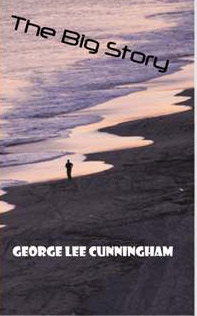Waiting and Watching: In the Path of a Tsunami
By: Ken Cable
About a dozen of us stood looking out to sea from the third floor overlook at Paki Maui resort waiting for the wave to materialize from out of the blackness. It was October 27, 2012. We had just learned that a 7.7 earthquake had hit off Canada’s west coast and that a huge tsunami was rolling across the Pacific Ocean and would collide with Maui at precisely 10:28 p.m. The expected height of the surge was estimated at five-and-a-half feet – potentially devastating.
The Hawaiian Islands lie in the middle of the Pacific Ocean, farther from any continental land mass than any other island in any other ocean. Viewed from that perspective, we were a forlorn little group huddled in a faraway place waiting for an angry tidal wave to surge over our seawall and sweep us away. All we needed to complete the Hollywood scenario was for the Fire Goddess Pele to stir things up on Haleakala, Maui’s dormant volcano.
Actually, we were more festive than forlorn, mainly because our full-time resident experts told us not to worry, the tsunami – if it arrived – would smack into the windward (east) side of Maui and we were safely on the lee (west) side. Thus assured, we chatted and joked, but I noticed that we checked the water level in the lagoon often. The clock ticked on.
When news of the Canadian earthquake interrupted most programs, all TV stations in Hawaii focused exclusively on the potential for a large tsunami. Authorities throughout the islands were ordering residents and visitors on the coastlines to evacuate to higher ground. TV shots of Honolulu demonstrated very clearly the enormous difficulty (in my view, impossibility) of suddenly evacuating large population centers anywhere in the world. The city was gridlocked by cars trying to flee to higher ground.
Here on Maui, we were jolted by shrieking sirens sounding up and down the coast. A police helicopter flew low along the condos and hotels with its own siren sounding a warning from the sky. It wasn’t long before policemen were running through our condo development, pounding on the first floor doors and ordering everyone to evacuate.
There is a new (new to us, anyway) approach to evacuation in Hawaii ahead of a potential tsunami. It’s called, Evacuate Up. We were told to climb at least to the third floor of our building, which would place us above even a severe wave strike. This is a reassuring tactic for us given that our building is a man-made Pali (cliff). Its construction is steel reinforced concrete and cinder block. A nearby earthquake a few years ago caused a crack in one corner, but the rest of the buildings only quivered a little.
So, as we got ready to evacuate up, a friend with an apartment on the third floor, appeared in our doorway and invited us to join him and his wife and some other neighbors in his home to wait out the threat. We happily accepted.
At 10 p.m. the sirens sounded even more urgently, and those of us on the overlook stared even more intently out to sea.
About two years ago, an earthquake near the Big Island (Hawaii) created a tsunami that did impact Paki Maui. The surge struck the windward side, then wrapped around the island to push up over our seawall so it could deposit sand and salt water on our lawn. This, our friends assured us, would be the only thing that might happen this time. The clock ticked on.
Hawaiians are justifiably concerned when a tsunami alert is sounded. They listen when authorities warn them to evacuate the coast. In 1960, an earthquake in Chile sent a huge tsunami across the Pacific that slammed into Hilo on the Big Island killing 61 people and destroying five hundred structures. The wave that struck Hilo was estimated at 35 feet. Even though our immediate threat was so much less, people headed for higher ground. A 35-foot wave just might reach up to our third floor overlook.
At 10:20 p.m. landscape lights cast soft illumination into our lagoon to reveal small wavelets lifting over the outer and inner reefs. We could clearly see the white foam as each one crested. Then it was 10:25, :26, :27 – and then 10:28. Our evacuees grew silent, :29, :30, :35, :50, then 11:00 o’clock came and went. No tsunami. At 11:30, we thanked our hosts, un-evacuated and went to bed. We awoke the next morning to overwhelming tranquility. The islands of Lanai and Molokai remained where they’ve always been, and the tide was ebbing slowly to reveal our outer reef. The windward side of Maui had experienced a two-foot surge that did not wrap around the island to our side.
I hope that no one reading this assumes that I take lightly the threat of tsunamis to any part of the world. In recent years we have seen the utter desolation these events can create. The threats are real to coastlines all over the world – just as are hurricanes that rise up out of the Gulf of Mexico and the Atlantic Ocean to regularly devastate other parts of the United States. Hurricane Sandy, which recently ripped into the East Coast is a devastating example.
Tornadoes, blizzards, fire storms and floods are all part of our collective experience and confirm that in the end, nature rules. When warnings come to nothing, we should count our blessings – and congratulate the men and women whose job it is to prepare us for these events – whether or not they come to pass. Hawaii did that very well.
It is evening several months later in Paki Maui. Sunset is upon us and we are compelled to watch. It is so much nicer than waiting for a tsunami. Aloha.
Ken Cable is a nature and travel writer. His new novel “Track of the Hunter” about a 16-year-old forest service intern on the trail of a poacher is due out this summer. His first novel, “Lost!” about three young boys attempting to survive in the high Sierras during a spring storm can be ordered at www.readerpublishing.com.










Comments
Thanks for the heads up. I have no problems at all on my Internet Explorer 10 program. But then I tried it on Internet Explorer 9 and saw the overlap. It seems almost impossible to get a website that shows up well on every browser. Is anybody else having similar problems?